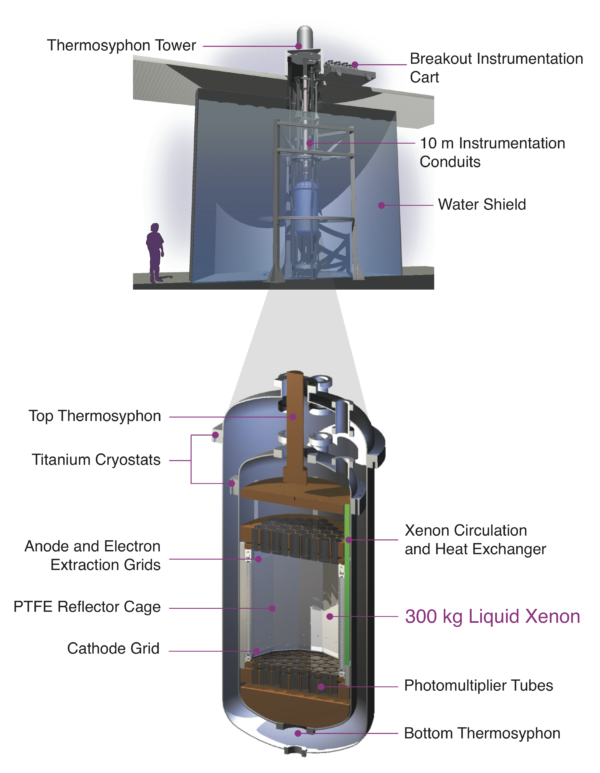If you want to find dark matter directly, your best hope is to gather a tremendous number of nucleons for it to interact with, wait an incredibly long period of time, and devise a device surrounding it capable of detecting even a single potential collision while distinguishing it from any background signals. That was the exact idea behind LUX, the Large Underground Xenon detector.
 A diagram of the LUX detector. Image credit: LUX Collaboration, diagram by David Taylor, James White and Carlos Faham.
A diagram of the LUX detector. Image credit: LUX Collaboration, diagram by David Taylor, James White and Carlos Faham.
After a 20 month run with more than a third of a ton of liquid Xenon inside, the LUX collaboration has released their final results. Not only did they achieve four times the sensitivity they anticipated, but they didn’t detect a single event. This eliminates most models of WIMP dark matter, including from scenarios like supersymmetry and extra dimensions.


What's the difference with this one, and the one to detect proton decay, such as the kamiokande? They look very much like the same thing, except for the 'filling'.
BTW it is a pitty that they can't place such a detector next to the LHC, to check if the collisions would generate waves that travel through the medium, be it the Higgs, Dark Matter or SpaceTime.
@Ethan wrote:
Won't be produced or won't be detected? If not produced, then why?
If produced, the would be detected by the energy missing from the particles the do detect. If you play pool and there is an invisible ball on the table, you can figure out when you hit it.
If I understand right, allowed Dark Matter particles are outside the energy levels the LHC runs at.
@MobiusKlein,
If you play pool and there is an invisible ball on the table, you can figure out when you hit it.
What if the 'invisible ball' is made of Fire and your other balls run just right through it; and you can't measure the change in temperature due to leeway or lack sensitivity of your measurement tools; only the momentum of the balls is observed, but not a change temperature? The devil is in the details.
It seems that you can't use something like this LUX sensor at the LHC due to too much 'noise'.
Well, "allowed" in the sense of SUSY-predicted WIMPs, which were supposed to be ~100 GeV. It's OK, the goalposts are rail-mounted at this point.
This null result again confirms that DM to be the aether of our time. If LUX-Zeppelin does not find DM, what then? What's the alternative?
IMO, it's really time to seriously consider MOG now. One of the strongest argument against MOG has been the Bullet Cluster data. However, Moffat has recently published a paper that shows that MOG explains that data. See http://www.perimeterinstitute.ca/personal/jbrownstein/mog/prediction/
and
https://arxiv.org/abs/1606.09128.
In fact, Moffat claims that MOG explains *all* the cosmological data collected so far. It's time to seriously consider MOG as an alternative to DM.
A very nice summary of Moffat's MOG work that explains the cosmological data *without* DM is given here:
http://www.johnwmoffat.com/pdfs/Miami2014.pdf
"This null result again confirms that DM to be the aether of our time."
Nope, it doesn't.
"Being visible" isn't a requirement of dark matter. Being an absolute frame of reference WAS a requirement of aether.
"It’s OK, the goalposts are rail-mounted at this point."
Chelle doesn't ascribe to the outmoded idea of goalposts. They're too limiting. Amorphous nonstatements and claims are much more amenable to chelle's "argument", therefore they supercede any rational desire to know what is being discussed in concrete and stable terms.
Wow,
Narad's reply was addressed to MobiusKlein.
That's an odd thing to say.
Um, off the top of my head, non-WIMP dark matter.
Meaning what? You have at least one practical test already.
Simply repeating this incantation does not add semantic content.